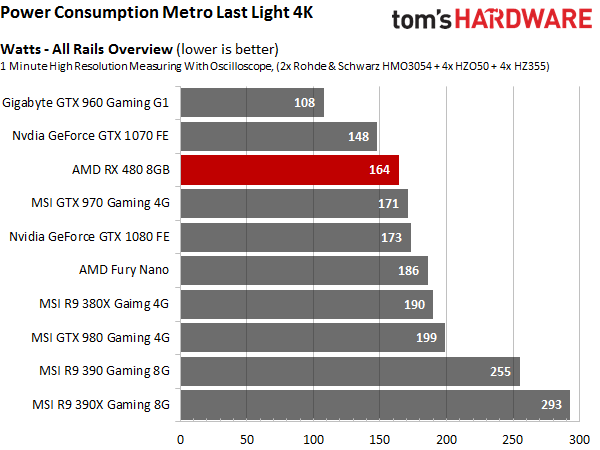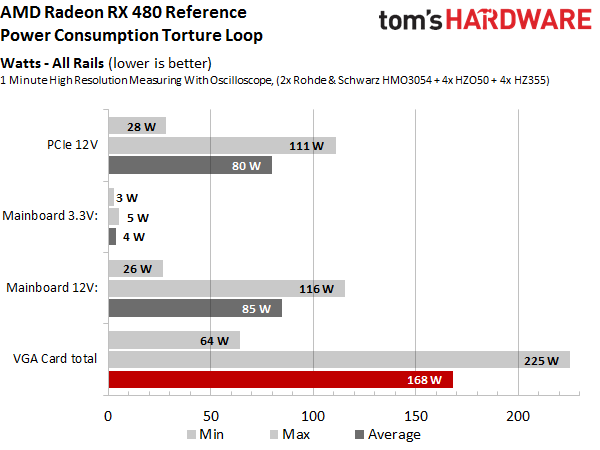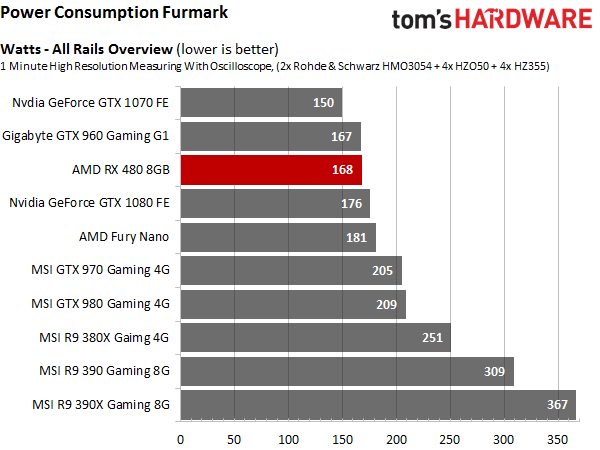AMD Radeon RX 480 8GB Review
Power Consumption Results
We're taking an even closer look at power than usual because we can't shake the feeling this card was designed for lower clock rates and less consumption. Don't worry, the following analysis explains this in greater depth. It just seems like there should be an eight-pin auxiliary connector on-board.
MORE: The Math Behind GPU Power Consumption And PSUs
| Power Consumption | |
|---|---|
| Test Method | Contact-free DC Measurement at PCIe Slot (Using a Riser Card) Contact-free DC Measurement at External Auxiliary Power Supply Cable Direct Voltage Measurement at Power Supply |
| Test Equipment | 2 x Rohde & Schwarz HMO 3054, 500MHz Digital Multi-Channel Oscilloscope with Storage Function 4 x Rohde & Schwarz HZO50 Current Probe (1mA-30A, 100kHz, DC) 4 x Rohde & Schwarz HZ355 (10:1 Probes, 500MHz) 1 x Rohde & Schwarz HMC 8012 Digital Multimeter with Storage Function |
Please note that the minimum and maximum states in the following tables don’t always occur at the same time. This is why the individual numbers for the rails don’t necessarily add up to the total for all of the rails.
Idle and Low-Load Power Consumption
The Radeon RX 480’s minimum GPU and memory clock rate is 300MHz, resulting in an idle power measurement of 16W (or 19W if you're using multiple monitors). That's simply too high for a modern graphics card. It was actually hard to take a stable reading at idle since even an empty Windows desktop is subject to load fluctuations. The card reacted quickly whenever these occurred, in spite of its high minimum frequency.
Blu-ray and 4K-MKV container playback came in at 36 to 42W. This is acceptable, but certainly not great.
Circling back to our idle measurements, many readers requested that we use a bar graph instead of a table to represent load distribution across the rails and connectors, as well as illustrating overall power consumption. We listened, and the results are as follows:
The seventh phase, which is responsible for the card’s memory, has to deal with an average of 2W and a peak of 3W. The remaining phases are distributed across the 12V rails, with an emphasis on PCIe connector's three phases. This would be a great setup if it stayed the same at higher loads.
Get Tom's Hardware's best news and in-depth reviews, straight to your inbox.
The following gallery contains all of the detailed measurement and analysis results:
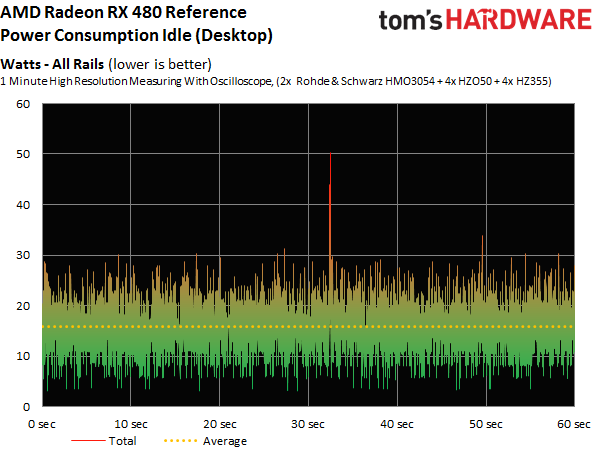
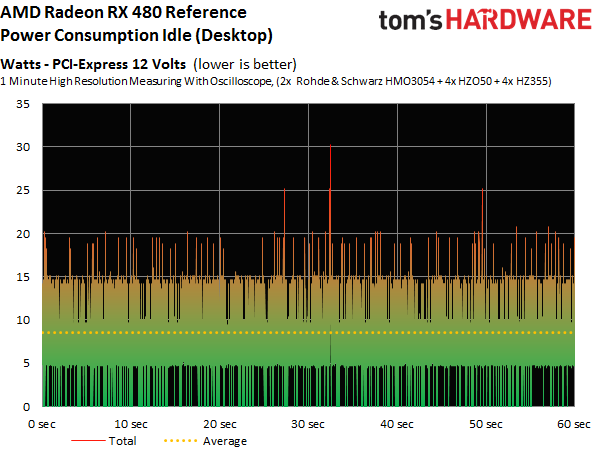

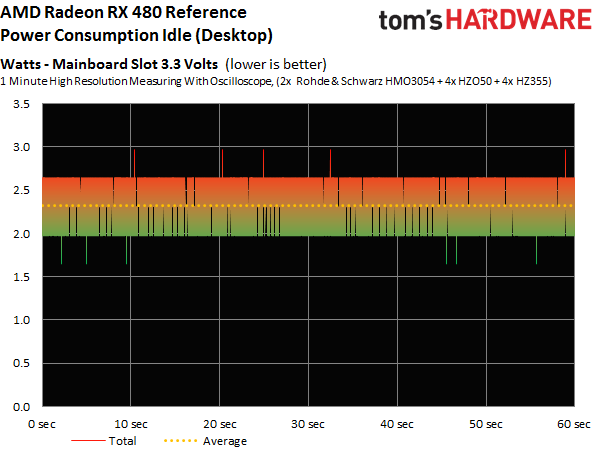
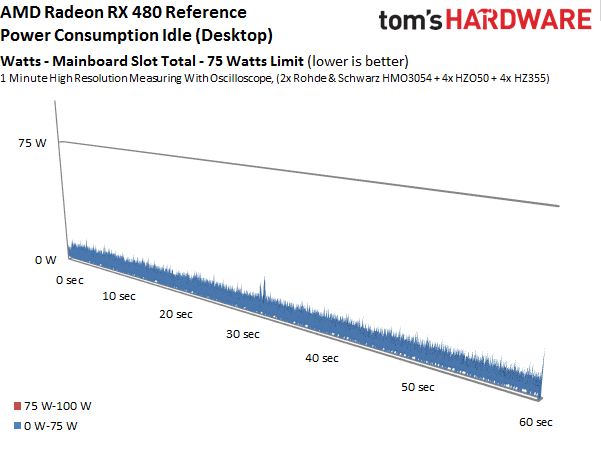
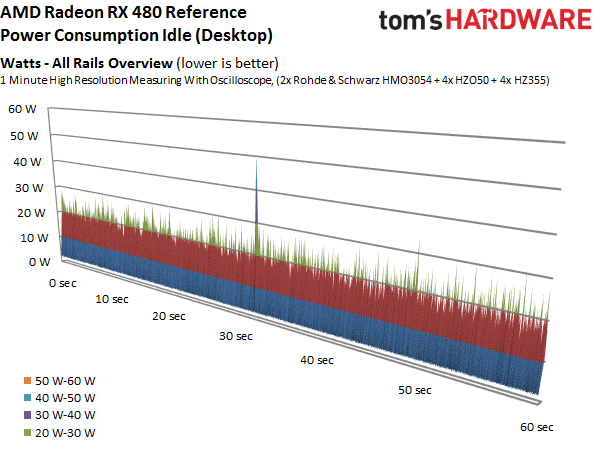
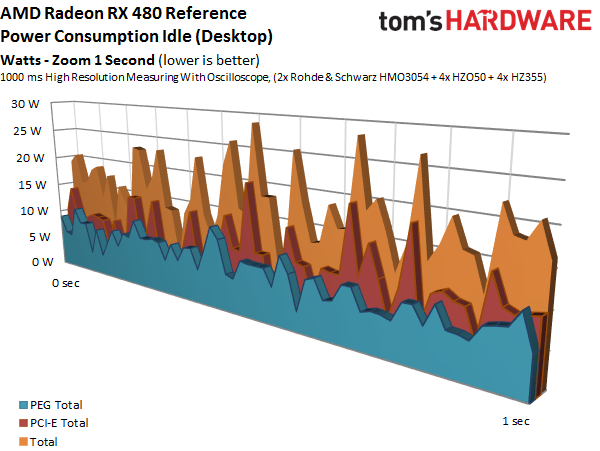
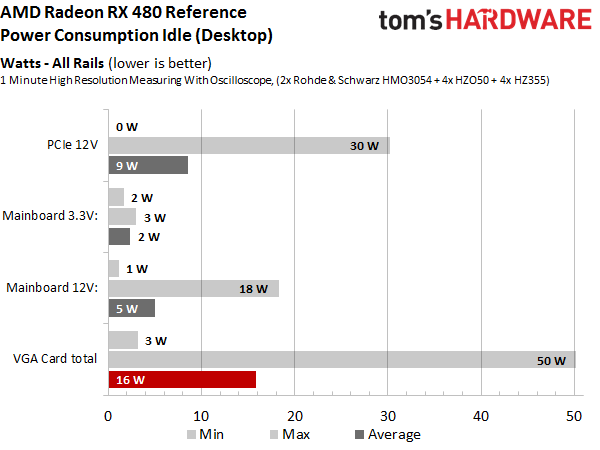
In conclusion, here’s a comparison with relevant graphics cards:
Gaming Power Consumption
The outcome of our gaming loop yields a a great example. AMD's GPU and Samsung's memory are equally stressed, so there's no real CPU bottleneck affecting performance. It’s also pretty close to a worst-case scenario in spite of load fluctuations during some scenes. Once again, we’re using a bar graph for our power consumption results to make it clear why we arrived at our (unfavorable) conclusions. It truly takes an observant eye to see why we bemoaned the lack of an eight-pin power connector and the power circuit's design.
AMD’s Radeon RX 480 draws an average of 164W, which exceeds the company's target TDP. And it gets worse. The load distribution works out in a way that has the card draw 86W through the motherboard’s PCIe slot. Not only does this exceed the 75W ceiling we typically associate with a 16-lane slot, but that 75W limit covers several rails combined and not just this one interface.
With peaks of up to 155W, we have to be thankful they're brief, and not putting the motherboard in any immediate danger. However, the audio subsystems on cheaper platforms will have a hard time dealing with them. This means that the "you can hear what you see" effect will be in full force during load changes; activities like scrolling may very well result in audible artifacts.
We’re also left to wonder what we'd see from a CrossFire configuration. Two graphics cards would draw 160W via the motherboard’s 24-pin connector; that's a tall order. Switching from the bars back to a more detailed curve makes this even more evident.
Here are the detailed results for the individual rails and connectors:

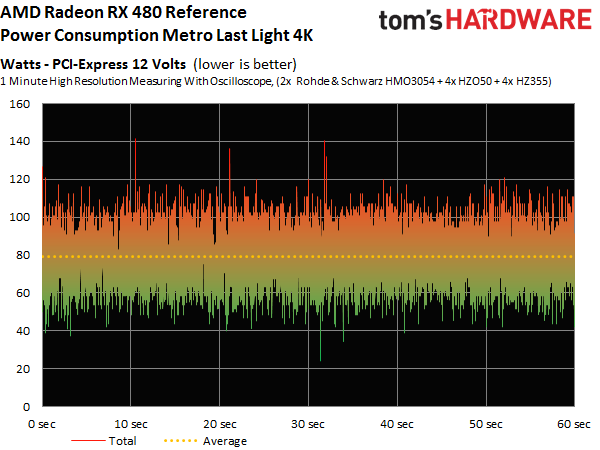
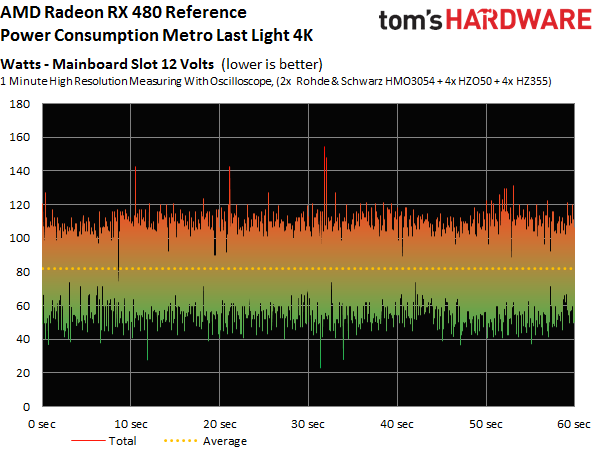
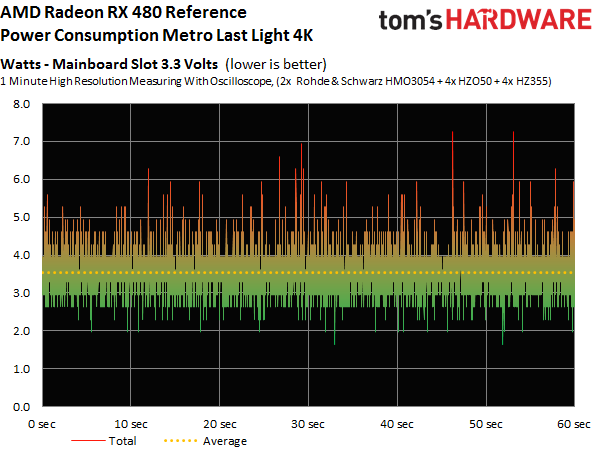
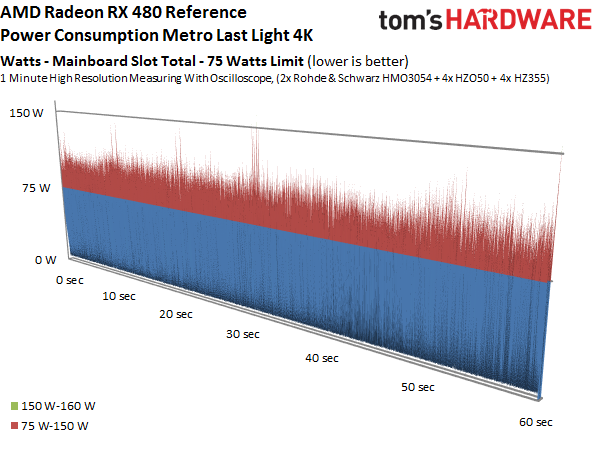
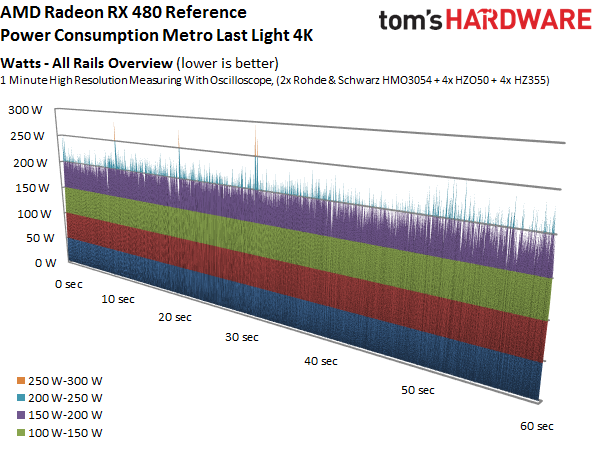
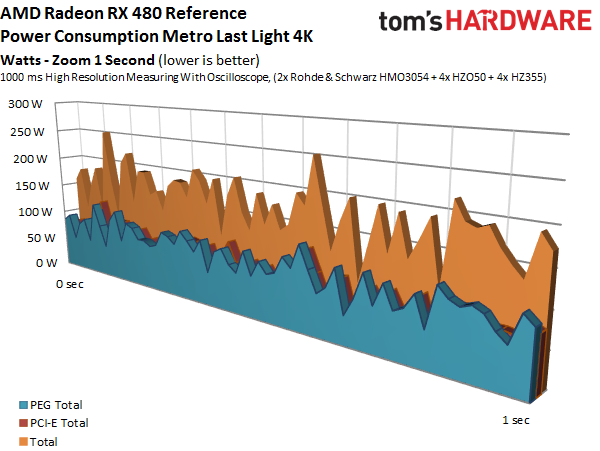
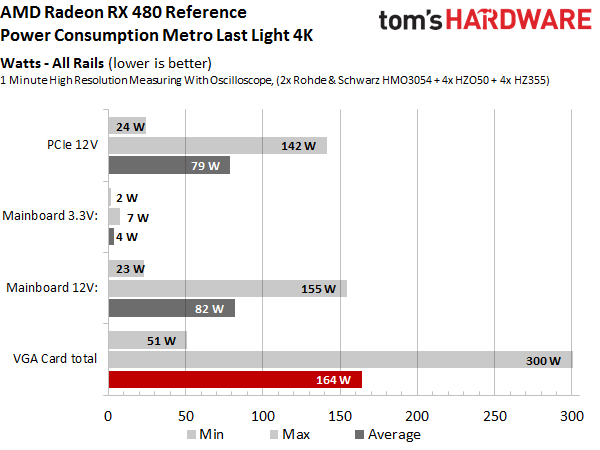
The smaller six-pin PCIe connector implies a more economical graphics card, but let’s be real here: an eight-pin connector would’ve been the way to go. The six phases could’ve been balanced for 30W each, totaling 180W. In such a configuration, two phases would have drawn a maximum of 60W through the motherboard.
We skipped long-term overclocking and overvolting tests, since the Radeon RX 480’s power consumption through the PCIe slot jumped to an average of 100W, peaking at 200W. We just didn’t want to do that to our test platform.
Here’s the comparison overview of our select group of graphics cards:
Stress Test Power Consumption
Believe it or not, the situation gets even worse. AMD's Radeon RX 480 draws 90W through the motherboard’s PCIe slot during our stress test. This is a full 20 percent above the limit.
To be clear, your motherboard isn't going to catch fire. But standards exist for a reason. All of the components around the PCIe slot and along the path from the slot to the 24-pin ATX connector will suffer from the peaks. And depending on your platform's design, audio problems may also materialize.
Once again, here are all of the detailed measurement results:








The comparison overview shows that some of Nvidia’s GeForce cards consume less power during the stress test, since GPU Boost recognizes the nature of the load and limits power consumption accordingly.
Bottom Line
There’s no doubt that Polaris is more efficient than its predecessors. However, the design's efficiency isn't what enthusiasts might have been hoping for. The Radeon RX 480 significantly exceeds its official TDP. Moreover, distribution between the motherboard’s PCIe slot and the auxiliary power connector isn't optimal either. It’s up to AMD’s partners to design cards without these shortcomings.
MORE: Best Monitors
MORE: How To Choose A Monitor
Current page: Power Consumption Results
Prev Page Professional Application Results Next Page Temperature & Noise Results-
chaosmassive this card will be my replacement of HD 7770 card for sure !Reply
thanks for the reviews, though power consumption from PCI slot is real concern here
-
asukafan2001 Seems like a decent card for what it is and what its target market is. Based off where the 1070 and 1080 fall in though i cant help but feel the 1060 which is targeted for the fall might make things uncomfortable for th 480. Nice to see amd working on power efficency though. That has always been a weakspot for them.Reply -
JeanLuc I can't help but think you need to revist this. The AOTS benchmark don't look right, the 480 is behind the 390, 390X and GTX980 in DX12.........I know this card is mid range and all that but it is 14nm with a revised chip design, surely it should be ahead of the last generation mid range cards even if it's by just a small amount.Reply
Edit: I stand corrected. Just looked at Anandtech and there results confirm what Toms is reporting. -
Oranthal Wow all the hype and it didn't deliver on any of it. Yes its an improvement but a marginal one and the supply is non existent. So its a paper launch as well. I was hoping this would be the solution to my 1440p 144hz freesync setup. Really disappointed, then again nothing lives up to online hype now. Nvidia's offerings hit the performance numbers we wanted but are insanely expensive. So I will keep waiting to see if drivers and oc's helps this card out or hope the 490 delivers.Reply
Edit: The cards are 100% available on newegg, I guess it took them until 9:30 to have them show up. I am still completely let down and hoping the partner cards and new drivers deliver on some performance gains. I guess its my fault for believing the hype that AMD could produce the same jump in the low to mid tier that Nvidia did for the high end. -
envy14tpe All that hype and finally the release....ahhh. We now have competition in the market place. The 960 and 970 have a good contender. Let's just hope price stays low as AMD doesn't play Nvidia's limited supply game.Reply
In Taiwan (where I am). There is one listing today selling the Gigabyte for $315usd. Prices need to get worked out. At that price I can get a 970.
-
rmpumper So basically AMD caught up to nvidia's now obsolete 9xx series? So much for the hype, though not unusual for AMD.Reply


